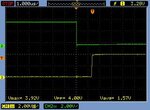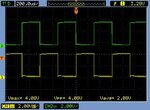chinuhark
Member level 5
Today I tested the hard wired deadtime circuit, and it was a 10 min task. The only time it took was getting the proper Resistors and Caps from the store. I mean it is so damn simple to get deadtime in hardware, I can't believe why people are so reluctant about it. Yes space is an issue, but it's not as complicated a circuit as we make it to be in our heads. All you need is a Resistor, a Cap, a high speed diode and a few NOT gates, which also double up as buffers btw.


As you can see, getting 1.2us deadtime. This will be later fine tuned using a precision Pot in the final circuit.
It's nice as all you need from the controller are the signals for the top or bottom 3 switches and you get the signals for the remaining switches along with dead time as the output. Thus you can literally use an Arduino for V/F.:grin:


As you can see, getting 1.2us deadtime. This will be later fine tuned using a precision Pot in the final circuit.
It's nice as all you need from the controller are the signals for the top or bottom 3 switches and you get the signals for the remaining switches along with dead time as the output. Thus you can literally use an Arduino for V/F.:grin:
